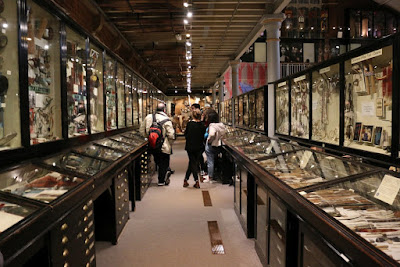Between the 11th and 18th of December we were staying in Berlin.
We saw many reminders of Berlin's turbulent recent history. The facade of the Anhalter Bahnhof (railway station) has been left as it was after the WWII bombing. The rest of the building has been demolished. From here 9,600 Jews were transported from 1941 to 1945.
A Holocaust Memorial has been created on land near the old Berlin wall. The memorial is made up of a grid of concrete blocks of different heights. In the centre they tower over you and are probably intended to be disorienting.
Most of the Berlin Wall, constructed by East Germany to stop citizens going to the west, has been removed. The East Side Gallery, painted by many invited international artists, is the largest section of Berlin Wall still standing. This picture depicts Leonid Brezhnev (USSR Leader) and Erich Honecker (East German Leader) greeting each other with a fraternal kiss. It reads '
Mein Gott, hilf mir, diese tödliche Liebe zu überleben', which in English means '
My God, help me survive this deadly love'.
One side of the wall holds the East Side gallery. The west side has more standard graffiti.
The East Berlin red and green men at pedestrian crossing are featured on tourist gifts. There are also bits of the wall to be purchased in various sizes. That these have become tourist gifts does nothing to remove from some people's memory how threatening it felt at one time with the border guards and spies everywhere. People were shot trying to cross the wall or swim the River Spree.
The most famous Berlin landmark is the Brandenburg Gate. The wall ran down there too cutting it off in no man's land.
Even the Reichstag was off limits until reunification, when by a small majority it was decided to move parliament back from Bonn to Berlin. The Reichstag interior was rebuilt and a dome added. The dome has a spiral walkway that gives views down into the chamber and out across the city. This is now the place were the German Government meet.
We also visited Charlottenburg Palace (porcelain room above) and learned about the first King of Prussia, and his wife Charlotte, who died before this and others rooms she had helped design were completed. We learned how a later King of Prussia became the Emperor of Germany in 1871, after the different German lands were united. The royal family had the name Hohenzollern. They had fairly humble origins but big military ambitions.
Berlin Zoo is a peaceful place for tourists to visit in the former western sector. On a cold day there are many indoor animal enclosures to help keep visitors and animals warm. It was the first time we ever saw a real Panda. The Male Panda (Jiao Qing) sat behind bamboo, eating the stalks. The female panda did some climbing on a rock, and ate bamboo as we watched. East Berlin made their own zoo, which still exists, and the two zoos now work together.
We also saw a lot of interesting art on our trip, both in the Gemaldegalerie, part of the new culture centre, and in the old National Gallery on museum island. We had hoped to visit the New National Gallery shown in our 2019 guide, but it is still being built. There is a lot of building work in Berlin.
During the visit I was reading Leaving Berlin, a novel which tells of the start of the cold war and the competing Russian, American and fledgling East German agents and informers. I finished the book on the return trip from Berlin Tegel to Gatwick Airport. In the book were place names, we had visited. That made the exciting story even more engaging.

















































